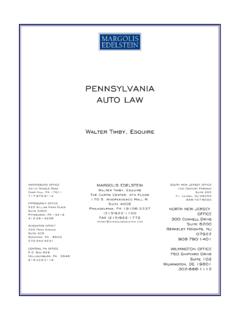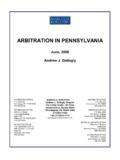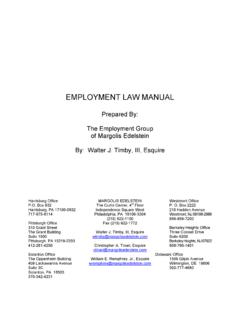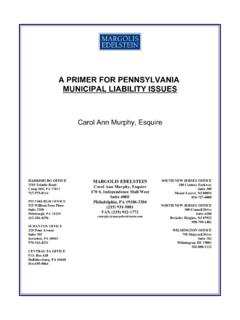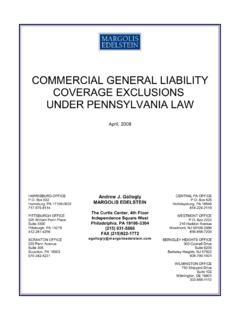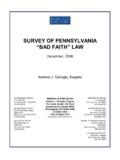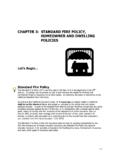Transcription of OVERVIEW OF NJ PIP LAW - Margolis Edelstein
1 OVERVIEW OF NJ PIP LAWT homas L. Grimm, EsquirePHILADELPHIA OFFICEThe Curtis CenterSuite 400E170 S. Independence Mall , PA 19106215-922-1100 HARRISBURG OFFICE3510 Trindle RoadCamp Hill, PA 17011717-975-8114 PITTSBURGH OFFICE525 William Penn PlaceSuite 3300 Pittsburgh, PA 15219412-281-4256 Margolis EDELSTEIN100 Century ParkwaySuite 200 Mount Laurel, NJ OFFICE220 Penn AvenueSuite 305 Scranton, PA 18503570-342-4231 CENTRAL PA Box 628 Hollidaysburg, PA 16648814-224-2119 BERKELEY HEIGHTS OFFICE300 Connell DriveSuite 6200 Berkeley Heights, NJ 07922908-790-1401 WILMINGTON OFFICE750 Shipyard DriveSuite 102 Wilmington, DE 19801302-888-1112- 1 - OVERVIEW OF NJ PIP LAWBy Thomas L. GrimmMargolis EdelsteinThe New Jersey Personal Injury Protection (PIP)/ No Fault statute, 39:6A-1, etseq, mandates speedy first-party payment of a range of benefits, including medical expenses, lostwages (income continuation benefits), essential services, survivor benefits and funeral expenses tocertain classes of persons injured in automobile accidents without any consideration of fault at to the passage of the AICRA Act in 1998, standard PIP coverage provided a mandatoryminimum limit of $250,000 in medical expense benefit coverage.
2 The AICRA Act reduced andlimited mandatory minimum PIP coverages previously required in New Jersey by making thosecoverages dependant on the choices made by consumers regarding their own economic status. Standard coverage now makes the previously mandatory $250,000 medical expense benefitthe default option, while providing for optional reduced coverage limits at $15,000, $50,000, $75,000and $150,000. If the policyholder chooses basic PIP coverage, the medical expense benefitcoverage is only $15,000 per person per accident, but allows for additional coverage not to exceed$250,000 for limited catastrophic specific injuries including permanent brain damage, spinal cordinjury, disfigurement, or other permanent and significant injuries treated at an acute care hospitalimmediately after an accident. Other PIP benefits available under a standard policy, such as incomecontinuation, essential services, or death benefits, are not included in basic policy coverage.
3 A thirdclass of insurance, denominated a special policy, is eligible to only low income individuals. Itprovides for even more limited coverage than the basic policy, but does allow for a $10,000 medical expenses : Pursuant to AICRA, coverage will only be allowed for those treatments, tests and services providedfor in the policy of insurance. Medical expenses is defined in the Act as meaning reasonable andnecessary expenses for treatment or services as provided by the policy, including medical, surgical,rehabilitative and diagnostic services and hospital expenses, provided by a health care providerlicensed or certified by the state or by another state or nation, and reasonable and necessary expensesfor ambulance services or other transportation, medication and other services as may be provided for,..and also including any non-medical or remedial treatment rendered in accordance with a recognizedreligious method of healing.
4 39:6A-2(e). The Act defines hospital expenses at :6A-2(f), and defines eligible health care providers at 39 be payable by PIP, medical expenses must be reasonable and medically necessary which isdefined by the Act as meaning that the treatment is consistent with the symptoms or diagnosis, andtreatment of the injury (1) is not primarily for the convenience of the injured person or provider, (2)is the most appropriate standard or level of service which is in accordance with standards of goodpractice and standard professional treatment , and (3) does not involve unnecessarydiagnostic testing. 39:6A-2(n).- 2 -Income continuation benefits:A claimant eligible for standard PIP coverage may recover income continuation benefits, , thepayment of the loss of income of an income producer as a result of bodily injury disability. Thedefault coverage is subject to a maximum weekly payment of $100, subject to a maximum limit of$5,200 on account of injury to any one person in any one accident.
5 Income continuation benefits arepayable upon written notice of loss, but cannot exceed the net income of the injured worker duringthe period he is receiving benefits, and are subject to setoff of certain specified collateral sources,including benefits collectible under workers compensation insurance, state temporary disabilitybenefits, Medicare, and benefits collected under federal law by military personnel. Incomecontinuation benefits continue for as long as the injured person is disabled from working because ofthe injuries , or until the benefit ceiling is exhausted. In the event of a worker s death, the full benefitamount is payable at services benefits:The Act provides for the payment of essential service benefits to an injured person to be made inreimbursement of necessary and reasonable expenses incurred for such substitute essential servicesordinarily performed by the injured person for himself, his family, and members of the family residingin the household, subject to a limit of $ per day, with a maximum limit of $4,380 on accountof injury to any one person in any one accident.
6 The statute permits a recovery of either $ a dayfor each day of the disability, whether or not payment for services was made on a daily basis, or$4,380 for the total period of the disability, whichever is less. Ordinarily, an injured person canrecover for essential services benefits only by way of reimbursement for actual expenditures to a thirdperson rendering services that had been provided by the injured person prior to incapacitation. Thus,normally, an injured person must prove that he or she actually paid someone to perform the serviceson his or her benefits: In the event of the death of an eligible person, two types of lump-sum death benefits are , if the decedent was an income producer, his survivors are entitled to payment of the maximumbenefit the income producer himself would have been entitled to for income continuation benefits, ,normally $5,200. Secondly, when the decedent provided essential services, his survivors are entitledto payment of the maximum essential service benefit, normally $4,380.
7 Neither benefit depends uponproof of actual loss of income or actual cost incurred by the survivors. Thus, all that is required tocollect death benefits is proof of the death of an eligible decedent, , one who was in fact an incomeproducer and one who was in fact providing essential 3 -Funeral expenses:The estate of an eligible decedent who dies as a result of injuries sustained in an automobile accidentis entitled to actual expenses of any funeral, burial, or cremation up to a maximum benefit of $1, respect to these additional classes of benefits, please note that an insured may choose topurchase additional optional benefits, , increased maximum levels of income continuation, essentialservice, and death for PIP benefits:There are three prerequisites to a successful claim for PIP benefits under an automobile policy. First,there must be a policy providing PIP benefits that is valid as to the individual making the , the claimant must be a member of one of the classes intended to receive benefits under thePIP statute, and third, the claimant must be able to show legal causation, , that he or she sufferedbodily injuries in an accident having a substantial nexus to the use or operation of a classes:The PIP statute requires automobile insurers to provide PIP benefits for the following: (1) tothe named insured and members of his family residing in his household who sustained bodily injurywhile occupying, entering into, alighting from or using an automobile, or as a pedestrian, caused byan automobile or by an object propelled by or from an automobile.
8 (2) to other persons sustainingbodily injury while occupying, entering into, alighting from or using the automobile of a namedinsured, with the permission of the named insured. A named insured is defined as not only theperson identified as a named insured on the policy, but also his or her spouse, if the spouse is namedas a resident of the same automobile requirement:With only two limited exceptions (very limited extended medical benefits, and PIP-typemedical benefits for certain bus passengers), PIP benefits are available only if the injured person is occupying, entering into, alighting from or using a qualifying automobile or is an insuredpedestrian struck by an automobile. The term automobile is defined by the statute as meaning aprivate passenger automobile of a private passenger or station wagon type that is owned or hired andis neither used as a public or livery conveyance for passengers nor rented to others with a driver; anda motor vehicle with a pickup body, a delivery sedan, a van, or a panel truck or a camper type vehicleused for recreational purposes owned by an individual or by husband and wife who are residents ofthe same household, not customarily used in the occupation, profession or business of the insuredother than farming or ranching.
9 An automobile owned by a farm family co-partnership orcorporation, which is primarily garaged on a farm or ranch and otherwise meets the definitions ofautomobile, shall be considered a private passenger automobile owned by two or more relativesresident in the same household. - 4 -In other words, when the vehicle is a traditional passenger sedan or a station wagon, thatalone, not its use, determines the insured s eligibility for PIP benefits. The only uses that precludePIP coverages for such a car are those expressly set out in the statute. Unlike the rule for pickuptrucks, vans, panel trucks and the like, there is no overall distinction between cars used in commerceand those used only for personal transportation. The commercial/personal use distinction is irrelevantfor passenger sedans or station wagons, unless they are used as a public or livery conveyance forpassengers or rented to others with a driver, , a taxicab.
10 Dune buggies and motorcycles are nevereligible for PIP benefits. While buses in general are not regarded as automobiles for PIP benefits,a 1991 amendment to the Act made eligible passengers on certain specified private buses. Passengerson school buses are not eligible for PIP from coverage:The PIP Act, specifically 39:6A-7 provides a number of specific exclusions to PIPbenefits, based upon the conduct of the claimant. If a claimant s conduct contributed to his death orinjury while committing a high misdemeanor or felony, or occurred while the claimant was seekingto avoid lawful apprehension or arrest by a police officer, or occurred while the claimant was actingwith a specific intent of causing injury or damage to himself or others, then he is excluded from PIPcoverage. Additionally, if the claimant was the owner of an automobile required to maintain PIPcoverage, which was uninsured at the time of the accident, he is excluded.
